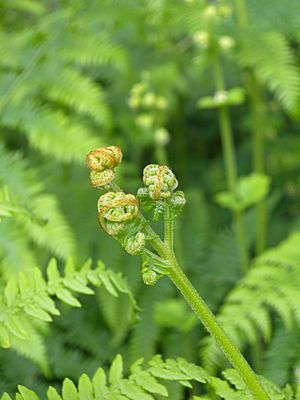Leptosporangiate fern facts for kids
Quick facts for kids Leptosporangiate fern |
|
|---|---|
 |
|
| Pteridium aquilinum | |
| Scientific classification |
|
| Kingdom: | Plantae |
| Clade: | Tracheophytes |
| Class: | Polypodiopsida |
| Subclass: | Polypodiidae Cronquist, Takht. & W.Zimm. |
| Orders | |
|
|
The Polypodiidae, commonly known as leptosporangiate ferns, are the biggest group of ferns. They are one of four main types of ferns. There are about 11,000 different kinds of these ferns all over the world. This makes them the largest group of living ferns.
These ferns are called leptosporangiate because of how their spore cases (sporangia) grow. Each spore case starts from a single cell on the fern's surface. Other ferns, called eusporangiate ferns, have spore cases that grow from a group of cells.
Leptosporangiate ferns often have a special cover called an indusium. This cover protects the sorus, which is a cluster of spore cases. The indusium can be a full cover, a ring, or even missing. Many of these ferns also have a ring called an annulus around their spore cases. This annulus helps to shoot out the spores when they are ready.
Contents
What Makes Them Special?
Leptosporangiate ferns are different from other fern groups. The other main groups are the marattioid ferns, horsetails, and whisk ferns and moonworts. There are many more leptosporangiate ferns than all other ferns combined. About one-third of these ferns grow as epiphytes. This means they grow on other plants, like trees, but they don't harm them.
How Scientists Classify Them
Scientists group living things to understand how they are related. The leptosporangiate ferns were first recognized as a special group in 1881. Over time, their classification has changed as scientists learn more.
In 2006, scientists used molecular phylogenetics to classify ferns. This means they looked at the DNA of ferns to see how they are related. This research helped them understand that even water ferns (Salviniales) belong to the leptosporangiate group.
Later, in 2014 and 2016, new classifications were made. These systems group all ferns into a class called Polypodiopsida. This class has four main subgroups, or subclasses. The Polypodiidae, or leptosporangiate ferns, are the largest of these subclasses. The other three are often called eusporangiate ferns.
Here's how the main fern groups are related:
| Polypodiopsida |
|
||||||||||||||||||
Fern Orders
The Polypodiidae subclass is divided into seven main groups called orders. These orders contain many different families, genera, and species of ferns. There are an estimated 10,323 species in total!
The seven orders are:
| Polypodiidae |
|
||||||||||||||||||||||||||||||||||||
How They Are Related to Other Plants
Scientists also use DNA to figure out how leptosporangiate ferns are related to other types of vascular plants. Vascular plants have special tissues to carry water and nutrients.
Here's a diagram showing how they might be related to other plant classes:
|
Eusporangiate
Ferns Leptosporangiate
Ferns |
Ancient Ferns: Extinct Families
Leptosporangiate ferns have a long history on Earth. We know this because many of their ancient relatives have been found as fossils. For example, fossils of ferns similar to today's Dicksoniaceae family have been found from the Lower Jurassic period. That was millions of years ago!
Scientists have described many extinct families of these ferns. These ancient families are not part of the classification systems used for ferns alive today. Some of these extinct families include:
- Anachoropteridaceae
- Botryopteridaceae
- Kaplanopteridaceae
- Psalixochlaenaceae
- Sermayaceae
- Skaaripteridaceae
- Tedeleaceae
- Tempskyaceae
See also
 In Spanish: Helechos leptosporangiados para niños
In Spanish: Helechos leptosporangiados para niños

